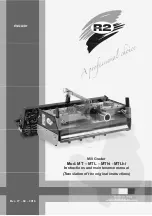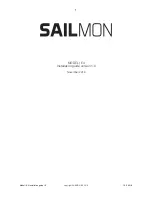
DATE: 09/26/01
P.N.: 28-0379/01
INSTRUCTIONS FOR CALIBRATING THE
LANCER CARBONATION TESTER, KIT PN 82-2449
NOTE
If needed, also see Lancer Instruction Sheet 28-0330/02, Carbonation Tester, Assembly
and Parts Listing, PN 54-0007/01.
1. PERMANENT MOUNTING AND CONNECTION OF THE CALIBRATOR
1.1
Determine a suitable location on the wall to mount the calibrator in the proximity of an air or CO
2
source. Included in the kit are drywall anchors and screws.
1.2
Position the calibrator on the wall so the gauge on the regulator is facing up and the calibrator is
level. Mark the location of the four (4) mounting holes.
1.3
Drill four (4) pilot holes and install four (4) drywall anchors.
1.4
Position calibrator over the anchors and secure to the wall using four (4) washers and four (4)
screws.
1.5
Connect end of hose assembly to an air or CO
2
source. This can be done with the 1/4 inch swivel
nut and flare seal already attached to the hose assembly.
NOTE
Do not attach the yellow fitting on the hose assembly to the two (2) prong plug on the calibrator at
this time.
2. CALIBRATING THE CARBONATION TESTER
2.1
Calibrating the Carbonation Tester Gauge
A. If the calibrator is not permanently mounted, remove it from the case and place it in a vertical
position.
B. Securely screw the carbonation tester cap assembly with the gauge on the top of the calibrator
tube so that the dial faces forward.
C. Using a screwdriver, turn the adjustment screw on the regulator counter-clockwise until it stops.
This will ensure the initial pressure on the calibrator tube is zero (0) psi.
D. Connect the calibrator to an air or CO
2
source. This can be done with the hose assembly
provided in the kit, or the two prong plug removed from a figal outlet can be used.
E. Slowly turn the adjustment screw on the regulator clockwise until the gauge on the calibrator
reads five (5) psi.
F. Gently tap the gauge casing of the carbonation tester gauge to ensure that the indicator has not
become stuck. The carbonation tester gauge should also read five (5) psi. If the gauge reads
correctly, proceed to the next step. If it does not read correctly, remove the gauge cover by
turning counter-clockwise. Using a screwdriver, turn the brass adjustment screw at the bottom
of the gauge face counter-clockwise to increase the pressure reading or clockwise to decrease
the pressure reading.
G. Repeat step 2.1.F at pressures of 10, 15, and 20 psi. Both gauges should read the same at all
four pressures (5, 10, 15, and 20 psi). If they do not, the gauge must be replaced.
If at any time
during the calibration procedure an adjustment is made, the entire procedure must be repeated
beginning at five (5) psi.
H. When the calibration is complete, slowly turn the adjustment screw on the regulator
counter-clockwise until the adjustment screw stops.
I.
Relieve the pressure from the calibrator tube by pressing the vent valve button on top of the cap
FAX ENGINEERING: • 210-310-7096
"Lancer" is the registered trademark of Lancer
•
Copyright — 2001 by Lancer, all rights reserved.
6655 LANCER BLVD. • SAN ANTONIO, TEXAS 78219 USA • (210) 310-7000
FAX SALES
• NORTH AMERICA – 210-310-7245 • INTERNATIONAL SALES – 210-310-7242 • CUSTOMER SERVICE – 210-310-7242 •
• LATIN AMERICA – 210-310-7245 • EUROPE – 32-2-755-2399 • PACIFIC – 61-8-8268-1978 •




















